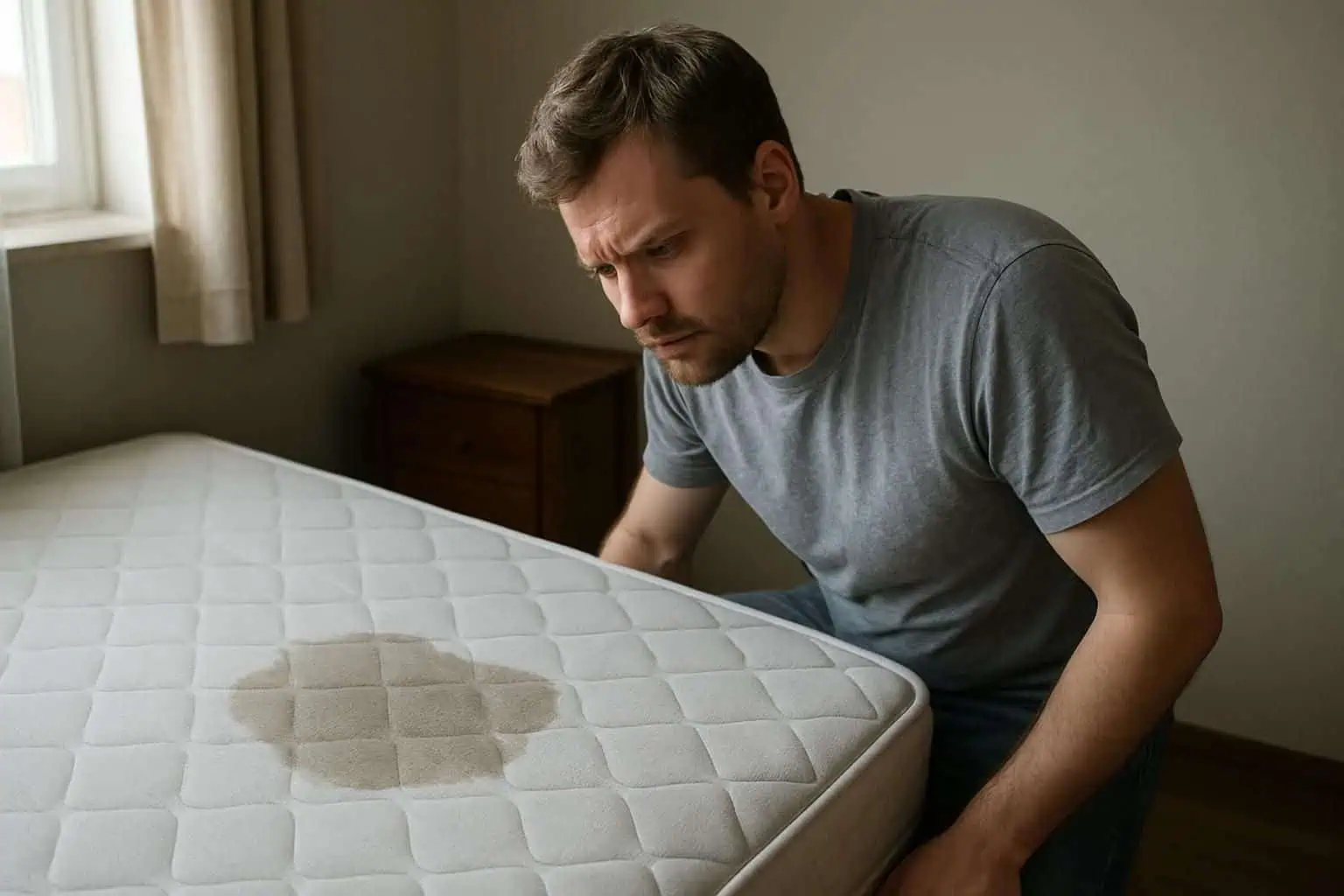It can be an uncomfortable and confusing experience, especially if you’re unsure of what caused it. One recent incident involved a person discovering a clear liquid on their bed, which was not urine, leading to questions about the source of the moisture.
In this comprehensive guide, we will explore 7 quick fixes to help you identify the cause of the wet spot, effectively clean your mattress, and ensure your bed stays dry night after night. There’s no need to feel embarrassed; solving this mystery starts right here.
Key Takeaways
Wet spots on your bed can result from various sources such as drool, pets, night sweats, spills, or even sexual activity. If your bedroom temperature is above 65°F, it can lead to increased sweating.
Consider using a waterproof mattress protector as an easy way to prevent stains and odors on your mattress.
For fresh wet spots, gently blot them with towels without rubbing. Enzyme-based cleaners work well for urine stains, while vinegar solutions are effective for other types of stains.
Adult bedwetting affects around 1-2% of men. If you experience sudden bedwetting, especially after the age of 50, it’s advisable to consult with your doctor.
Allow fresh air into your bedroom daily for 15 to 30 minutes to maintain good ventilation. Opt for breathable cotton sheets over synthetic materials for better comfort.
Common Causes of a Wet Spot on the Bed
There are several common causes of finding a wet spot on your bed. It could be due to:
Night sweats: If you experience excessive sweating while sleeping, it can lead to a wet spot on your bed.
Spills: Accidental spills of water, beverages, or any liquid can result in a wet patch on your bed.
Pet accidents: If you have pets that sleep on your bed, they may have accidents that leave wet spots.
Drooling: Some people may drool in their sleep, which can cause moisture buildup on the bed.
Sexual activity: Intimacy can sometimes lead to wet spots on the bed due to bodily fluids.
Medical conditions: Certain medical conditions like nocturnal enuresis (bedwetting) or excessive sweating can contribute to wet spots.
By identifying the specific cause of the wet spot, you can take appropriate measures to prevent it from happening again in the future. Remember to follow the tips provided in this guide to effectively clean and maintain your mattress for a comfortable and dry sleep environment. They might blame night sweats, spills, or even their own drooling before realizing their pet is the culprit.
Keeping your pet clean and well-groomed can help minimize these incidents. Regular vet check-ups and addressing any health issues promptly can prevent unexpected wet spots.
If your pet has an accident on your bed, clean it up as soon as possible to prevent stains and odors. Use a pet-safe cleaner to ensure your furry friend stays healthy and your bed stays fresh.
Intimacy-Related Issues

Sexual activity can lead to wet spots on your bed, but it’s not always from sweat or bodily fluids. Sometimes, spilled drinks or even accidental drooling during sleep might be to blame.
It’s important to address any intimacy-related issues with your partner openly and honestly. Discuss any concerns or discomfort, and work together to find solutions that work for both of you.
Investing in a quality mattress protector can help prevent wet spots from ruining your mattress. These waterproof covers are easy to clean and can save you from the hassle of dealing with stains and odors.
Remember, wet spots on your bed can happen for a variety of reasons, but with some awareness and proactive measures, you can minimize their occurrence and enjoy a dry, comfortable night’s sleep.
When it comes to wet spots on your bed, it’s important to not jump to conclusions. Our vet has seen numerous cases where owners assumed something else caused the wetness, only to discover a different underlying cause.
Spot’s damp patches aren’t always just drool or spilled water. Vets at JustAnswer have noted that pets dealing with anxiety or bladder issues can sometimes leak small amounts without anyone noticing. Quick cleanup is essential in these situations to prevent permanent stains and odors from setting in. Another common reason for beds turning damp is unexplained clear fluid, which we will explore further.
Unexplained Clear Liquid

Finding clear liquid on your bed can be puzzling, but there are a few possible explanations. Sexual activity often leaves behind fluids, such as male ejaculation or female ejaculate, which have distinct textures and scents when dry. Men may also experience wet spots after “wet dreams,” a natural occurrence that can happen at any age.
It’s important to understand that both partners can contribute to bed wetness during intimacy, reducing unnecessary worry and embarrassment.
Night sweats are another common culprit for wet spots, particularly if you naturally sweat a lot or are on certain medications. Sweat can feel sticky or watery, with minimal odor. Accidental spills, whether from drinks in bed or pets having accidents, can also result in similar marks.
To prevent frequent bed wetting, consider using a waterproof mattress protector for easy cleanup and to keep your bed dry.
Sexual Activity and Intimacy
It’s completely normal for sexual activity to leave wet spots on your bedding. These spots are typically a result of sweat, male ejaculation, and female ejaculation, also known as squirting. The composition of female ejaculate fluid varies in studies, with some detecting traces of urine and others identifying different substances.
To avoid staining your mattress, using waterproof sheets or mattress protectors during and after intimacy can help contain fluids before they seep through. This not only prevents damage to your bedding but also simplifies cleanup.
Medical Conditions That May Cause Bed Wetting or Wetness

There are various medical issues that can lead to wet spots on your bed beyond your control, ranging from bladder problems to hormonal changes affecting your nighttime bodily functions.
Adult Bedwetting (Nocturnal Enuresis)
Adult bedwetting, known as nocturnal enuresis, affects a small percentage of men nationwide. This condition occurs when you unknowingly urinate during sleep due to insufficient production of antidiuretic hormone at night, leading to excess urine production by the kidneys.
Other factors contributing to adult bedwetting include urinary tract infections (UTIs) or an enlarged prostate obstructing normal urine flow. Despite the embarrassment that often accompanies this issue, seeking medical help is crucial. A urologist can conduct tests to identify underlying physical causes like bladder spasms or urine leakage.
Bedwetting is not confined to childhood; it affects millions of adult men who suffer silently due to shame.
Treatment options, such as medications like desmopressin to reduce nighttime urine production, are available for those struggling with adult bedwetting. It’s essential not to let concerns about wet sheets impact your sleep or self-esteem, as healthcare professionals can address this common issue.
Urinary Incontinence
Urinary leakage is a prevalent issue among men, often left unaddressed due to embarrassment. This condition typically occurs due to an overactive bladder, where muscles contract excessively, leading to sudden leaks.
Prostate problems, bladder cancer, nerve damage, and certain medications like clozapine and risperidone can exacerbate urinary leaks by compromising the body’s ability to retain urine. Seeking guidance from a urologist specializing in men’s urinary health is the first step towards managing this issue. They may recommend a urodynamic test to evaluate bladder function accurately.
Treatment for urinary incontinence may involve exercises or medications like Vesicare to calm bladder muscles. If leaks are accompanied by discomfort or unusual symptoms, prompt medical attention is necessary to address potential underlying concerns.
With proper care and intervention, many men experience significant improvements in managing urinary incontinence.
Hyperhidrosis (Excessive Sweating)
Hyperhidrosis, characterized by excessive sweating even in cool environments, can be challenging to manage. It is classified into primary and secondary types, with primary hyperhidrosis resulting from nerve-induced sweat gland activation.
Secondary hyperhidrosis, on the other hand, is linked to underlying health conditions such as diabetes or thyroid disorders. Despite the discomfort it causes, many men remain silent about their hyperhidrosis struggles. As someone who has dealt with sweaty underarms affecting professional situations, I understand the impact excessive sweating can have on your daily life.
Identifying hyperhidrosis is relatively straightforward, as frequent sweat episodes typically occur in specific areas symmetrically on your body. Excessive sweating can lead to bothersome damp patches on your sheets, disrupting your sleep and potentially damaging your mattress.
Using a reliable mattress protector can prevent sweat absorption, preserving your bed and ensuring a comfortable night’s rest.
Steps to Identify the Source of the Wet Spot

Pinpointing the cause of a wet spot on your bed is crucial for effective resolution. By examining the liquid’s color, smell, and other characteristics, you can determine the underlying issue causing the wetness.
Inspect the Liquid’s Appearance and Smell
Closely observe the characteristics of the damp spot to gain insights into its origin. Clear and odorless liquid may indicate sweat or spilled water, while yellowish spots with a strong odor are likely urine, potentially signaling urinary incontinence.
Sticky or white patches are often remnants of sexual activity, while rusty or brownish hues could suggest blood, warranting medical attention.
Your sense of smell can detect issues that may not be visible to the naked eye.
A rapid olfactory examination can often provide more insight into a mysterious wet spot than a mere visual inspection. Pets are usually the culprits behind stains with unmistakable animal scents, while spilled food and beverages have their own distinct appearance and odor that are relatively simple to identify. Let your senses serve as your investigator, but be cautious when dealing with unknown liquids without proper protection.
Blotting gently with paper towels can assist you in determining the source of the dampness. This quick assessment aids in directing the cleanup process and alerts you to the need to consult your doctor regarding potential bladder issues or other health concerns.
First and foremost, rule out pets or external spills when examining the spot. Take a close look at the area—does it appear or smell unusual? Your pets frequently leave accidental wet spots, drool, or damp fur in their wake. The presence of pet hair or paw prints nearby typically indicates that cats or dogs are to blame. On the other hand, if you had a beverage in bed—a glass of water, beer, or coffee—it is possible that someone inadvertently knocked it over. Clear, odorless liquid generally indicates a spill of water rather than sweat or urine. However, if pets or spilled drinks do not appear to be the cause, night sweats or urinary issues may be to blame for the dampness.
Medical problems are frequently the cause of the wet spots found on your bed. Watch for signs such as the need to urinate frequently at night or sudden bedwetting. For instance, Dr. Patel discovered that a 54-year-old man who suddenly began wetting the bed was suffering from bladder outlet obstruction. In men over the age of 45, wet spots may indicate diabetes or prostate problems. Monitor your urine output and take note of any burning sensations during urination. Excessive sweating at night could also be a factor—hyperhidrosis leads to profuse sweating during sleep. Keeping track of your bathroom visits and recording details in a journal may help in identifying the true cause of these wet spots on the bed.
Next, let’s discuss simple methods for cleaning and managing these spots.
Wet spots on your bed require prompt action to preserve your mattress. You must quickly absorb the liquid and then clean with appropriate products to prevent stains and odors.
To absorb and remove excess liquid, grab a clean towel as soon as you notice a wet patch on the bed. Press it firmly onto the area, soaking up as much moisture as possible. Avoid rubbing, as this pushes the wetness deeper into the mattress. Continue blotting the spot, moving your towel to dry sections each time, until no visible liquid remains. If the area is still damp, sprinkle some baking soda over it. Baking soda helps draw out any remaining moisture and eliminates any potential odors that may develop. Immediately remove your sheets to minimize damage. Acting quickly can prevent stains from setting and reduce the risk of odors developing. After blotting with towels, use a vinegar solution on stubborn urine spots or spills. Vinegar’s natural acids break down stains and kill germs that could cause skin irritation or dermatitis. Allow the mattress to air dry completely before putting fresh sheets back on. Otherwise, hidden moisture could lead to mold growth right beneath your sleeping area.
When it comes to cleaning solutions for stains and odors, you’ll need effective cleaners for tough stains. For urine marks, opt for an enzyme cleaner or a mixture of vinegar and water. These options break down urine and prevent odors that may irritate your skin later on. Blood stains require a different approach. Create a paste by mixing hydrogen peroxide with cornstarch and salt, spread it over the stain, allow it to dry, and then gently brush it off. For drink spills, simply blot with a sponge and mild soap if you act quickly. This method works for fresh spills as well as older stains. Matching your cleaner to the source of the mess will keep your mattress fresh and free from harsh chemical odors or skin irritations.
Properly drying the mattress is just as important as cleaning a mattress stain. Use fans to improve airflow, directing one or two directly onto the damp areas. Avoid using hair dryers or space heaters, as heat can damage the mattress fabric or promote mold growth deep within. Sprinkling baking soda generously onto the wet area and propping the mattress up slightly can help moisture escape more quickly. This technique is ideal for sweat stains, bedwetting accidents, or unexpected incidents during intimate moments. If the humidity is high, drying may take longer, and mold may develop. Therefore, try to keep the room well-ventilated and open a window if possible. A completely dry mattress helps prevent itchy, irritated skin—discomfort that you definitely want to avoid, similar to the issues that prompt many women to undergo a pap smear.
Men over the age of 50 who experience sudden bedwetting should contact a doctor immediately. Dr. Patel provides an example—a 54-year-old man who begins wetting the bed for the first time should promptly see a urologist. Your body may be sending an important signal, so it’s crucial to seek medical attention if urine-soaked bed spots occur more than once, especially if you’ve been dry at night for at least six months. Clear liquid, rather than sweat or spilled drinks, may indicate urinary control issues. If you experience burning or itching sensations along with bedwetting, it’s time to consult a healthcare professional. Antifungal creams like clotrimazole may provide temporary relief for certain symptoms, but it is crucial to consult a doctor to accurately diagnose the underlying issue.
In cases of bedwetting, reconstructive urology treatments offer effective solutions, eliminating the need for embarrassment when seeking professional assistance.
To prevent future wet spots on your bed, consider implementing the following tips:
1. Use a Waterproof Mattress Protector: Invest in a waterproof mattress protector to shield your mattress from sweat, spills, and other liquids. Opt for organic cotton covers with safe waterproof layers for enhanced comfort and easy maintenance.
2. Maintain Proper Bedroom Ventilation: Ensure proper airflow in your bedroom by opening windows for fresh air circulation. Consider using a dehumidifier in humid conditions to prevent damp patches and mold growth. Use breathable cotton sheets and check for leaks or water damage in your room.
3. Monitor Hydration Before Sleep: Limit consumption of coffee and alcohol before bedtime to reduce nighttime urination. Stay hydrated throughout the day and consider drinking a small glass of water an hour before bed. Adjust your bedroom temperature and use a humidifier if necessary to maintain optimal hydration levels.
As we look ahead to 2025, advancements in smart bed technology will revolutionize the management of wet spots. These innovative beds will feature sensors to detect moisture instantly, providing precise insights into the cause of damp areas. New breathable yet waterproof mattress covers will simplify cleanup and prevent odors and stains.
In conclusion, taking proactive measures such as using a waterproof mattress protector, ensuring proper bedroom ventilation, and monitoring hydration levels can help prevent future wet spots on your bed. Embracing upcoming advancements in smart bed technology will further enhance the management of bed wetness, offering tailored solutions for individual needs.
Understanding Individual Differences in Fluid Levels
Every woman is unique, and this uniqueness extends to the quantity of fluids her body produces. This article explores the variations in fluid levels among women and how it can manifest in different ways.
Factors Influencing Fluid Quantity
Several factors can influence the amount of fluid a woman’s body produces. These factors include age, hormonal fluctuations, overall health, and hydration levels. Younger women may experience different fluid levels compared to older women, and hormonal changes during menstruation or menopause can also play a role.
Types of Fluid Variations
Fluid variations in women can present in various forms, such as night sweats, excessive saliva production, bedwetting, or urinary incontinence. These conditions may be temporary or chronic, and they can impact a woman’s daily life and overall well-being.
Managing Fluid-Related Issues
It is essential for women to pay attention to their bodies and seek medical advice if they experience abnormal fluid levels. Depending on the underlying cause, treatment options may include lifestyle changes, medication, or therapy to address the issue effectively.
Conclusion
Fluid quantity varies from woman to woman, and it is important to recognize and address any abnormal changes in fluid levels. By understanding the factors influencing fluid production and knowing how to manage fluid-related issues, women can take control of their health and well-being.
https://www.healthdirect.gov.au/night-sweats
https://www.colgate.com/en-us/oral-health/adult-oral-care/excessive-saliva
https://sanisnooze.com/how-to-clean-a-mattress-after-a-bedwetting-accident/
https://www.justanswer.com/dog-health/4ks12-y-o-female-lab-sometimes-leaves-wet-spots-whether.html
https://www.medicalnewstoday.com/articles/321625
https://flo.health/menstrual-cycle/health/vaginal-discharge/watery-vaginal-discharge-meaning
https://www.beaumont.org/conditions/enuresis
https://www.webmd.com/urinary-incontinence-oab/bed-wetting-in-adults (2024-09-20)
https://www.mayoclinic.org/diseases-conditions/hyperhidrosis/symptoms-causes/syc-20367152 (2024-10-25)
https://www.wagnermeters.com/concrete-moisture-test/concrete-info/moisture-problems-flooring-slab/
https://www.cepsorbents.com/resources/7-steps-to-spill-response/
https://www.newpig.co.uk/expertadvice/prepared-spills-7-step-guide-spill-response/
https://www.medicalnewstoday.com/articles/bedwetting
https://paywall.grupoahora.net.br/virtual-library/u10AEC/2341932/keratosispilaristreat.pdf
https://www.wikihow.com/Clean-a-Wet-Bed
https://www.saintlukeskc.org/health-library/coping-bedwetting
https://ehs.umass.edu/proper-ventilation-guidelines
https://drinkflowater.com/how-to-stay-hydrated-overnight/
https://www.stanley1913.com/blogs/how-to-guides/guide-to-drinking-water-before-bed (2022-12-22)
https://www.mayoclinic.org/diseases-conditions/bed-wetting/diagnosis-treatment/drc-20366711 (2023-08-24)
The Benefits of Outdoor Exercise
In today’s fast-paced world, many people find it challenging to make time for exercise. However, incorporating outdoor exercise into your routine can have numerous benefits for both your physical and mental health.
One of the primary advantages of outdoor exercise is the exposure to natural sunlight. Sunlight is a natural source of vitamin D, which is essential for maintaining strong bones and a healthy immune system. Spending time outdoors can also improve your mood and reduce feelings of stress and anxiety.
Additionally, outdoor exercise provides a change of scenery from the typical gym environment. Being surrounded by nature can help you feel more connected to the world around you and provide a sense of tranquility. Whether you’re jogging through a park, hiking in the mountains, or cycling along a scenic trail, outdoor exercise allows you to explore new surroundings and discover hidden gems in your community.
Another benefit of outdoor exercise is the opportunity to challenge your body in different ways. Uneven terrain, varying inclines, and changing weather conditions can all add an extra level of difficulty to your workout. This can help improve your balance, coordination, and overall fitness level.
Furthermore, outdoor exercise can be a more cost-effective option than joining a gym or purchasing expensive equipment. All you need is a good pair of running shoes, comfortable workout attire, and a desire to explore the great outdoors. There are countless free outdoor activities you can enjoy, such as running, cycling, hiking, and swimming.
In conclusion, incorporating outdoor exercise into your routine can have a multitude of benefits for your physical and mental well-being. Whether you’re looking to improve your fitness level, reduce stress, or simply enjoy the beauty of nature, spending time outdoors can have a positive impact on your overall health. So, lace up your shoes, step outside, and discover the many benefits of outdoor exercise for yourself. Are you tired of the same old routine and looking for a unique experience? Look no further than the enchanting world of immersive theater. Immersive theater is a form of performance art that breaks down the barriers between the audience and the actors, creating a truly immersive experience that transports you to a different world.
Imagine walking into a theater and being greeted by actors who seamlessly blend in with the crowd. You are not just a passive observer, but an active participant in the story that unfolds around you. You may find yourself following characters into different rooms, engaging in conversations, or even solving puzzles to advance the plot.
One of the most exciting aspects of immersive theater is the element of surprise. You never know what to expect next, as the performance is not confined to a stage but can take place all around you. This sense of unpredictability keeps you on the edge of your seat and fully engaged in the experience.
Immersive theater also allows for a deeper connection with the characters and the story. By interacting with the actors in a more intimate setting, you are able to gain a deeper understanding of their motivations and emotions. This creates a more meaningful and memorable experience that stays with you long after the performance is over.
In addition to its entertainment value, immersive theater also offers a unique opportunity for personal growth. By stepping out of your comfort zone and engaging with the unknown, you can develop new skills such as problem-solving, communication, and empathy. This can lead to increased self-awareness and a greater appreciation for the world around you.
So, if you are looking for a one-of-a-kind experience that will challenge you, inspire you, and leave you in awe, consider stepping into the world of immersive theater. It is a journey like no other, where the boundaries between reality and fiction blur, and the possibilities are endless.

